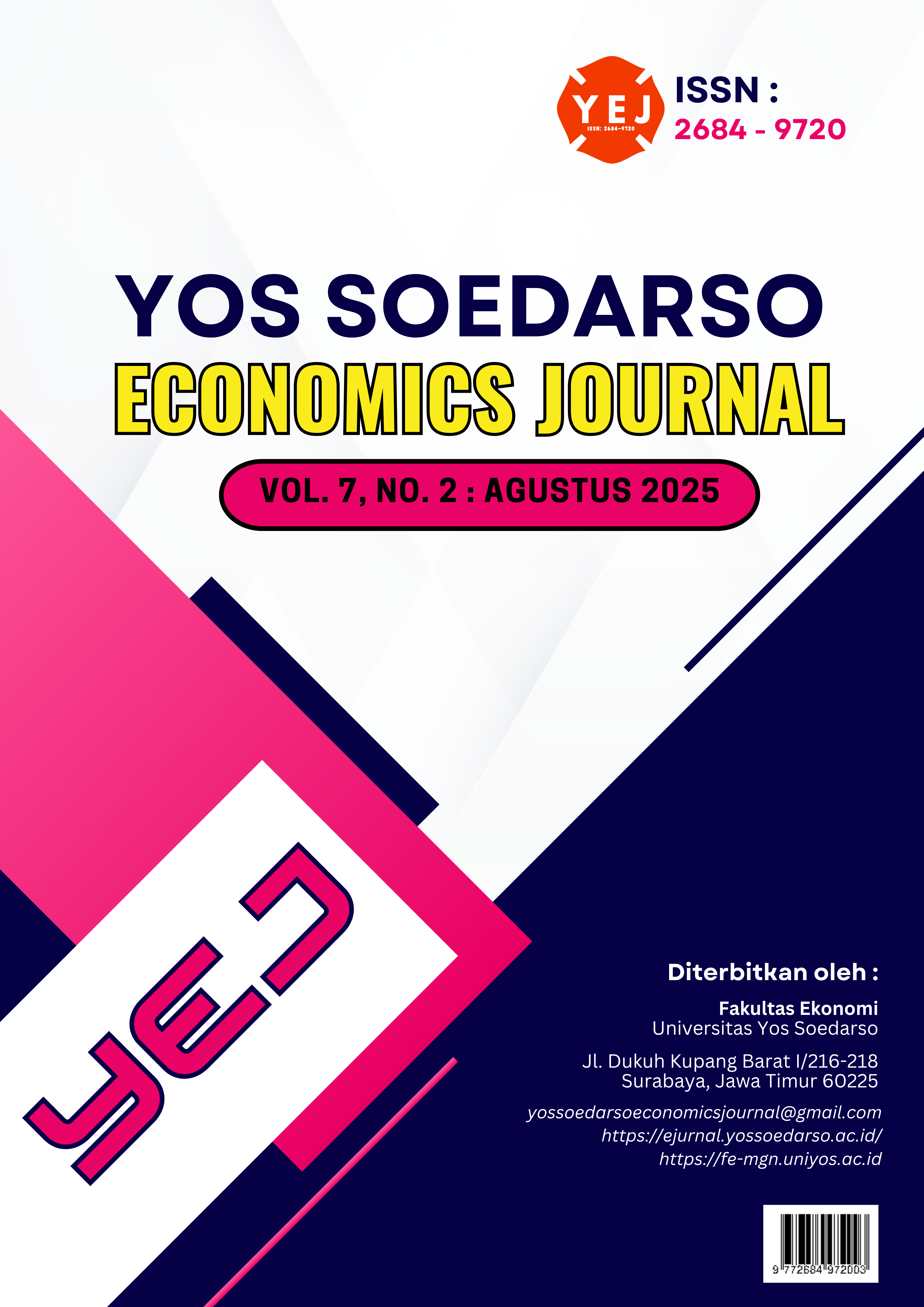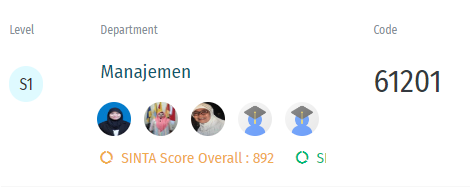Model Adaptif Kolaborasi Dinamis Dalam Green Logistics: Menuju Transformasi Bisnis Berkelanjutan Dalam Konteks Perkotaan
Keywords:
adaptive model, green logistics, dynamic collaboration, business sustainability, supply chainAbstract
This article proposes a conceptual adaptive model of dynamic collaboration in green logistics. This model serves as a vital strategy for business sustainability, with the primary objectives of minimizing ecological impacts and improving operational efficiency. This study identifies trends, challenges, and opportunities in collaborative approaches through the integration of Green Supply Chain Management (GSCM), Triple Bottom Line (TBL), Dynamic Collaboration Theory, and Open Innovation Theory. The discussion covers various forms of collaboration, from strategic partnerships to the use of digital technologies for adaptive coordination. Particular attention is paid to the contribution of dynamic collaboration to achieving circular economy goals, reducing carbon emissions, and enhancing supply chain resilience in urban logistics, particularly in Surabaya. This conceptual framework is expected to provide theoretical insights and practical guidance for academics, practitioners, and policymakers in designing logistics strategies that are economically viable, environmentally responsible, and socially just.References
Abideen, A. Z., Sorooshian, S., Sundram, V. P. K., & Mohammed, A. (2023). Collaborative insights on horizontal logistics to integrate supply chain planning and transportation logistics planning - A systematic review and thematic mapping. Journal of Open Innovation: Technology, Market, and Complexity, 9(3), 100066.
Atmayudha, A., Syauqi, A., & Purwanto, W. W. (2021). Green logistics of crude oil transportation: A multi-objective optimization approach. Cleaner Logistics and Supply Chain, 1, 100002.
Carter, C. R., & Easton, P. L. (2011). Sustainable supply chain management: Evolution and future directions. International Journal of Physical Distribution & Logistics Management, 41(1), 46–62.
Centobelli, P., Cerchione, R., Esposito, E., & Shashi. (2023). Digital technologies for sustainable supply chain management: A systematic literature review. The International Journal of Logistics Management, 34(1), 1-28.
Cheng, Y., Masukujjaman, M., Sobhani, F. A., Hamayun, M., & Alam, S. S. (2023). Green Logistics, Green Human Capital, and Circular Economy: The Mediating Role of Sustainable Production. Sustainability, 15(2), 1045.
Chesbrough, H. W. (2003). Open Innovation: The new imperative for creating and profiting from technology. Harvard Business Press.
Christopher, M., & Holweg, M. (2017). Supply Chain 2.0 revisited: A framework for managing volatility-induced risk in the supply chain. International Journal of Physical Distribution & Logistics Management, 47(1), 2–17.
Cui, H., Lu, Y., Zhou, Y., He, G., Song, S., Yang, S., & Cheng, Y. (2023). Carbon flow through continental-scale ground logistics transportation. iScience, 26(1), 105792.
Dekker, R., Bloemhof, J. M., & van Nunen, J. A. E. E. (2021). The role of logistics in a circular economy: A systematic review of the literature. Transportation Research Part D: Transport and Environment, 90, 102636.
Dyllick, T., & Muff, K. (2015). Clarifying the Meaning of Sustainable Business: Introducing a Typology From Business-as-Usual to True Business Sustainability. Organization & Environment, 29(1), 1–19.
Elkington, J. (1997). Cannibals with forks: The triple bottom line of 21st century business. Capstone Publishing.
Geissdoerfer, M., Pieroni, M. P. P., Pigosso, D. C. A., & Soufani, K. (2020). Circular business models: A review. Journal of Cleaner Production, 277, 123741.
Gholami, H., & Al-Hawari, M. A. (2021). Green supply chain management and firm performance: The mediating role of environmental collaboration. International Journal of Production Economics, 231, 107842.
Gligor, D. M., Holcomb, M. C., & Feizabadi, J. (2016). An exploration of the strategic antecedents of firm supply chain agility: The role of a firm’s orientations. International Journal of Production Economics, 179(September), 24–34.
Govindan, K., & Hasan, R. (2020). A systematic review of sustainable supply chain management literature: A bibliometric analysis. Journal of Cleaner Production, 250, 119565.
Guo, Y., Huang, T., & Wu, X. (2024). The impact of digital technology on green logistics performance: An empirical study. Computers & Industrial Engineering, 189(February), 109988.
Ju, C., Liu, H., Xu, A., & Zhang, J. (2023). Green logistics of fossil fuels and E-commerce: Implications for sustainable economic development. Resources Policy, 85, 103991.
Kale, P., & Singh, H. (2007). Building Firm Capabilities Through Learning: The Role of the Alliance Learning Process in Alliance Capability and Firm-Level Alliance Success. Strategic Management Journal, 28(10), 981–995.
Karaman, A. S., Kilic, M., & Uyar, A. (2020). Green logistics performance and sustainability reporting practices of the logistics sector: The moderating effect of corporate governance. Journal of Cleaner Production, 258, 120718.
Kemp, R., Rammer, C., & Arundel, A. (2023). Chapter 10: Measuring environmental (eco-) innovation. In: Handbook of Innovation Indicators and Measurement (pp. 177-196). Edward Elgar Publishing.
Kim, D., Na, J., & Ha, H.-K. (2024). Exploring the impact of green logistics practices and relevant government policy on the financial efficiency of logistics companies. Heliyon, 10(10), e30916.
Korhonen, J., Honkasalo, A., & Seppälä, J. (2018). Circular Economy: The Concept and its Limitations. Ecological Economics, 143, 37–46.
Lai, K.-h., Feng, Y., & Zhu, Q. (2023). Digital transformation for green supply chain innovation in manufacturing operations. Transportation Research Part E: Logistics and Transportation Review, 175, 103145.
Liu, C., & Ma, T. (2022). Green logistics management and supply chain system construction based on internet of things technology. Sustainable Computing: Informatics and Systems, 35, 100773.
Maji, I. K., Mohd Saudi, N. S., & Yusuf, M. (2023). An assessment of green logistics and environmental sustainability: Evidence from Bauchi. Cleaner Logistics and Supply Chain, 6, 100097.
Mohsin, A. K. M., Tushar, H., Hossain, S. F. A., Chisty, K. K. S., Iqbal, M. M., Kamruzzaman, M., & Rahman, S. (2022). Green logistics and environment, economic growth in the context of the Belt and Road Initiative. Heliyon, 8(6), e09641.
Muñoz-Villamizar, A., Mahecha-Lizarazo, R., & Montoya-Torres, J. R. (2019). Collaborative last-mile distribution: A literature review. Computers & Industrial Engineering, 133, 109-122.
Rezaei, J., Kianfar, F., & Azar, M. (2024). A novel multi-objective optimization for green logistics planning and operations management: From economic to environmental perspective. Computers and Industrial Engineering, 189(February), 109988.
Samad, S., Kabir, G., & Hasin, M. A. A. (2021). Evaluation of Green Supply Chain Management performance: A case study in the logistics sector. Journal of Cleaner Production, 316, 128316.
Sargani, G. R., Zameer, H., & Wang, Y. (2020). Sustainable logistics and the triple bottom line: A systematic literature review. Sustainability, 12(11), 4501.
Sarkis, J. (2019). Green supply chain management: A concise introduction. Routledge.
Schaltegger, S., Lüdeke-Freund, F., & Hansen, E. G. (2016). Business models for sustainability: Origins, present research, and future avenues. Organization & Environment, 29(1), 3–10.
Sharma, M., Luthra, S., Joshi, S., Kumar, A., & Jain, A. (2023). Green logistics driven circular practices adoption in industry 4.0 Era: A moderating effect of institution pressure and supply chain flexibility. Journal of Cleaner Production, 383, 135284.
Sikder, M., Wang, C., Rahman, M. M., Yeboah, F. K., Alola, A. A., & Wood, J. (2024). Green logistics and circular economy in alleviating CO2 emissions: Does waste generation and GDP growth matter in EU countries? Journal of Cleaner Production, 449, 141708.
Starostka-Patyk, M., Bajdor, P., & Białas, J. (2024). Green logistics performance Index as a benchmarking tool for EU countries environmental sustainability. Ecological Indicators, 158, 111396.
Whittington, R., Cailluet, L., & Yakis-Douglas, B. (2011). Opening strategy: Evolution of a precarious profession. British Journal of Management, 22(3), 531–544.
Yuen, K. F., Wang, X., Wong, Y. D., & Zhou, Q. (2019). The role of trust in achieving effective green supply chain management. Transportation Research Part E: Logistics and Transportation Review, 129, 240–253.
Xu, C., & Li, L. (2024). The dynamic relationship among green logistics, technological innovation and green economy: Evidence from China. Heliyon, 10(4), e26534.
Yingfei, Y., Mengze, Z., Zeyu, L., Ki-Hyung, B., Andriandafiarisoa Ralison Ny Avotra, A., & Nawaz, A. (2022). Green logistics performance and infrastructure on service trade and environment-Measuring firm’s performance and service quality. Journal of King Saud University - Science, 34(1), 101683.
Zhuang, X. (2024). Digital Analysis of Logistics and Supply Chain Management Innovation of E-commerce Enterprises in Green Economy. Applied Mathematics and Nonlinear Sciences, 9(1), 1–20.









